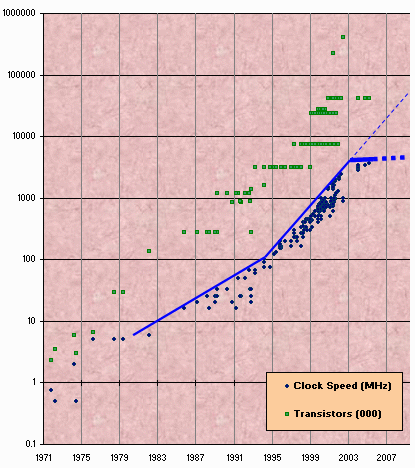Barely enough to pay for one lead scientist and a couple of research assistants.
Plus, you need to understand what a fundamental problem waste heat has become for the computer industry:
Around the beginning of 2003, youll note a disturbing sharp turn in the previous trend toward ever-faster CPU clock speeds. Ive added lines to show the limit trends in maximum clock speed; instead of continuing on the previous path, as indicated by the thin dotted line, there is a sharp flattening. It has become harder and harder to exploit higher clock speeds due to not just one but several physical issues, notably heat (too much of it and too hard to dissipate), power consumption (too high), and current leakage problems.

Quick: Whats the clock speed on the CPU(s) in your current workstation? Are you running at 10GHz? On Intel chips, we reached 2GHz a long time ago (August 2001), and according to CPU trends before 2003, now in early 2005 we should have the first 10GHz Pentium-family chips. A quick look around shows that, well, actually, we dont. Whats more, such chips are not even on the horizonwe have no good idea at all about when we might see them appear.
Well, then, what about 4GHz? Were at 3.4GHz alreadysurely 4GHz cant be far away? Alas, even 4GHz seems to be remote indeed. In mid-2004, as you probably know, Intel first delayed its planned introduction of a 4GHz chip until 2005, and then in fall 2004 it officially abandoned its 4GHz plans entirely. As of this writing, Intel is planning to ramp up a little further to 3.73GHz in early 2005 (already included in Figure 1 as the upper-right-most dot), but the clock race really is over, at least for now; Intels and most processor vendors future lies elsewhere as chip companies aggressively pursue the same new multicore directions.
Well probably see 4GHz CPUs in our mainstream desktop machines someday, but it wont be in 2005. Sure, Intel has samples of their chips running at even higher speeds in the labbut only by heroic efforts, such as attaching hideously impractical quantities of cooling equipment. You wont have that kind of cooling hardware in your office any day soon, let alone on your lap while computing on the plane
http://www.gotw.ca/publications/concurrency-ddj.htm